What are Squash Bugs?
Squash bugs. Those scary, prehistoric-looking insects that are the bane of gardens, large and small. True to their name, they prefer squash plants, such as yellow squash, acorn squash, crookneck squash, patty pan (scallop) squash, and zucchini. But these garden pests will also attack other cucurbits like pumpkins, cucumbers, gourds, and melons.
Adult squash bugs vary somewhat in color from gray-brown to gray-black, with some having light brown markings along the edge of their abdomen. Their flat bodies, which can also vary somewhat, are about 1/2″ long and are shaped like a shield with a triangle on the back.
A Case of Mistaken Identity
Adult squash bugs are often mistaken for stink bugs, which is not surprising considering they are both a part of the Coreidae family of sap-sucking insects. The stink bug can be distinguished from the squash bug by its wider body. Both insects put off a foul odor when disturbed or smashed.
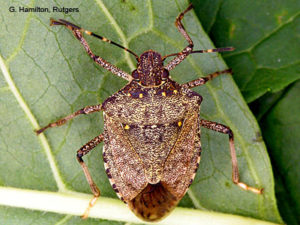
Squash bugs are also confused with leaf-footed bugs, another member of the Coreidae family. However, the latter is easy to identify because of the noticeable “leaf” shape flare located on each of its hind legs. Still, others mistake squash bugs for kissing bugs–a kind of assassin bug–which have a narrow “stick-like” head or “cone-nose.”
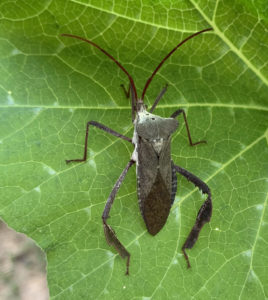
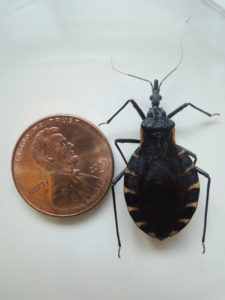
I’ve noticed when searching for images of these insects online that many of them have been misidentified. If you use the internet to help you identify bugs, be sure to use a site that you trust.
Life Cycle
Instead of pupating as many insects do, the squash bug transitions from an egg, to nymph, to adulthood. When temperatures turn warm, adult squash bugs will come out from rocks crevices, woodpiles, or wherever they’ve overwintered. They will fly to cucurbits in your garden where they will lay soft, yellow eggs that will harden and turn copper-colored. The eggs are laid in clusters, usually on the underside of leaves. The female squash bug will lay between one and three clusters at a time with each cluster containing approximately 15-20 eggs. Compare this to the squash vine borer, another enemy of the cucurbit gardener, which does not lay its eggs in clusters. This difference should make it easier to determine which kind of squash pest you’re dealing with.
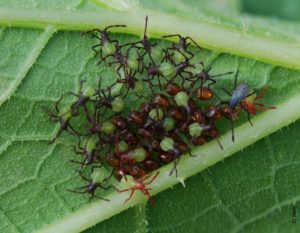
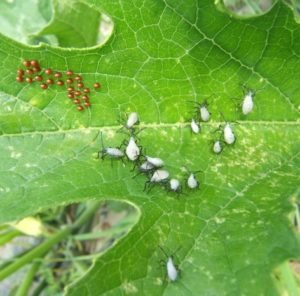
After about one week, soft-bodied nymphs with red or black legs will emerge from the eggs. This is the first of five instars or nymph stages that the insect will undergo. As the nymphs mature and move through the instars, they will become gray-green before turning darker and losing their “fuzzy” appearance. The process takes about one month, and when they reach the final instar, they will look like miniature versions of the adult squash bug.
Damage to Your Garden
Because squash bugs are often found in large numbers, they can do considerable damage. Unfortunately, adults and nymphs alike pierce leaves, stems, vines, and fruit with their proboscis to suck the sap out of the plant. Leaves, for example, will be marked with yellow specks where they have been pierced. These sites will turn brown and then, depending on the severity, turn black before dying. Vines that have been attacked will wilt.
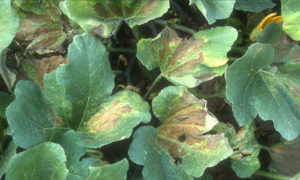
If that isn’t bad enough, squash bug saliva carries a bacteria called Serratia marcescens, which causes Anasa or cucurbit yellow vine disease. The bacteria can cause the plant to wilt and die, depending on the severity of the infection. In other words, if the plant doesn’t die from its sap being sucked out, it might die from the bacteria.
How to Get Rid of Squash Bugs Organically
1. Remove Insects and Eggs by Hand
This can be the easiest, safest, and cheapest method to rid your garden of these pests. Pick the bugs off by hand and drop them in a container of soapy water. If you find eggs, simply smash them or scrape them into the container as well.
Duct Tape
You can also loop a piece of duct tape around your hand with the sticky surface facing out, to pick up the squash bugs and eggs.
Set Out Board Traps
Take advantage of the squash bug’s natural tendency to hide under objects at night, by placing boards around your cucurbits. Early in the morning, turn the boards over to expose them and either smash them or place them in a container of soapy water.
This article contains affiliate links. If you make a purchase using one of these links I will receive a very small commission at no additional cost to you, and it will help me maintain this website. Rest assured, I only recommend products I actually like!
2. Diatomaceous Earth
To control squash bug populations, dust your plants with food grade diatomaceous earth (DE). Diatomaceous earth is a fine powder-like substance made from fossilized marine life. When an insect moves across the powder, the sharp micro-fragments scrape the exoskeleton, causing it to die.
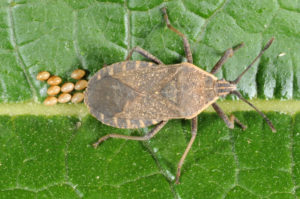
While DE can be used for all developmental stages after the eggs have hatched, it is somewhat more effective on nymphs than it is on adults. If it rains or the plant gets wet, you’ll need to reapply it. Also, be sure to wear eye protection and do not inhale the powder, which can be potentially harmful to your lungs. What’s more, DE can be harmful to pollinators, so you need to apply it late in the day after they have left the garden and try not to dust the flowers.
3. Insecticidal Soap
You can purchase an insecticidal soap, but it will often contain unwanted chemicals. You can easily and inexpensively make your own at home by adding two tablespoons of Castile soap, or other chemical-free soap, to a one gallon sprayer filled with water. Mix well. Filling the container with water and then adding the soap will help minimize the suds.
Always do a test spray on one leaf and wait 24-48 hours to see if the solution is too strong. If the test spray does not harm the leaf, spray the plant, including the underside of the leaves. You will want to spray in the early morning or at dusk because the combination of sun and soap can burn the plants. Be sure to coat the plant but don’t over-spray. Spray every three days for the first few weeks after you see evidence of squash bugs.
4. Neem Oil
Neem oil comes from the seeds of the neem tree, an evergreen from India. It works well on a variety of insects, including squash bugs and aphids. Neem oil works differently than insecticidal soap in that it does not kill the insects right away. Instead, it interferes with their hormones, preventing them from reaching maturity and reproducing. Neem oil also serves to repels insects.
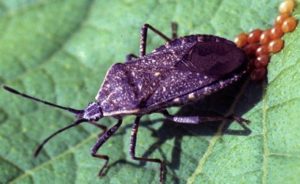
Many commercially available sprays contain harmful chemicals in addition to the neem oil. Alternatively, you can make your own spray. Start with 1-2 teaspoons of pure, cold-pressed neem oil with the naturally occurring compound, Azadirachtin, as this is more effective. This is the neem oil I use. Mix with 1/2 teaspoon of Castile soap like Dr. Bonner’s, and 1 quart of water. Again, always do a spray test on a leaf and wait 24 to 48 hours to see results before spraying the rest of the plant. You will want to spray in the early morning or at dusk because the combination of sun and neem oil can burn the plants. Monitor the plant and apply every seven days or so.
5. Introduce Parasitic Insects Into Your Garden
You can also control squash bugs by introducing parasitic flies and wasps to your garden. A fly called Trichopoda pennipes lays its eggs on both adult squash bugs and nymphs. When the eggs hatch, the larvae will burrow into its prey and eat it.
Parasitic wasps, such as Encyrtidae and Scelionidae, can also be effective against squash bugs, as well as other garden pests. Check with your local plant nursery to find out availability for your area.
6. Trap Plants
It may be helpful to plant sacrificial squash plants to lure the squash bugs away from your desired crop. This will be more effective if your desired crop is a bug resistant variety, and the trap plant is a susceptible variety. (See #5 below)
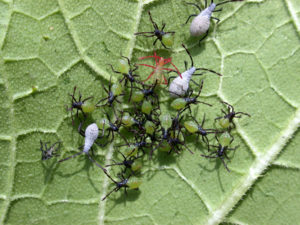
How To Prevent Squash Bugs
There are many things you can do to minimize and even prevent squash bugs from wreaking havoc in your garden.
1. Keep your garden and surrounding area clean of debris where adult squash bugs may overwinter.
2. Routinely inspect your plants, daily if possible, for eggs, nymphs, and adult squash bugs, especially as plants begin to flower. Check under the leaves, near the base of the plant, and along the stems, being as thorough as possible.
3. Plant nasturtiums, dill, tansy, peppermint, spearmint, and even catnip around your squash plants to deter squash bugs. However, be aware that catnip may attract cats. Since mint varieties tend to want to take over your garden, you may want to plant it in containers.
4. Use row covers, or similar material if you are gardening in containers, to protect young plants from adult squash bugs. You’ll need to make sure the edges are secured. Once the plants begin to flower, however, you’ll need to remove the covers for pollination.
5. Plant varieties that are resistant to squash bugs such as Butternut, Black Zucchini, and Royal Acorn. Your favorite seed company should be able to provide you with options.
6. Refrain from using bark or leaf mulch around your cucurbits as this provides cover and camouflage for the squash bugs. If you must use mulch, periodically spray water around the base of the plant so that the adult squash bugs and nymphs will come out from hiding and move to higher ground. When they do, you can remove them by hand or spray them using one of the above methods.
While squash bugs can be a formidable foe, you can take these measures to prevent an infestation. Or, should you find them in your garden, you’re now armed with proven methods to get rid of them and mitigate any damage.
Thank you for reading this article! If you found it helpful, please consider sharing it via email or social media. Thank you!
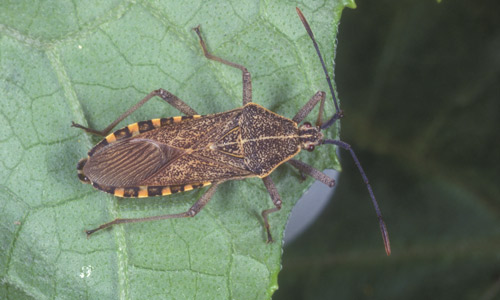
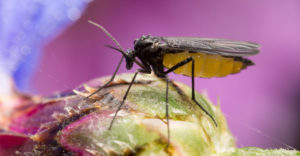
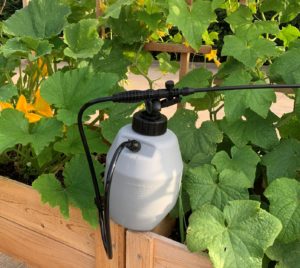
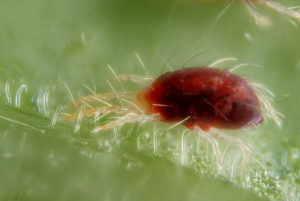

This is an awesome article! Thank you so much. I realize what I thought were lead-footed bug eggs were squash bug eggs. I sprayed them with insecticidal soap and they never hatched. Was I just lucky or do you think that’s a good way to kill then? Of course I could just snip off the lead.
Thanks for reading and commenting! Glad to know the article cleared up the difference between the two insects for you. As for the eggs, I think the safest, quickest, and most effective way to get rid of them is to simply remove the leaf. Happy Gardening!